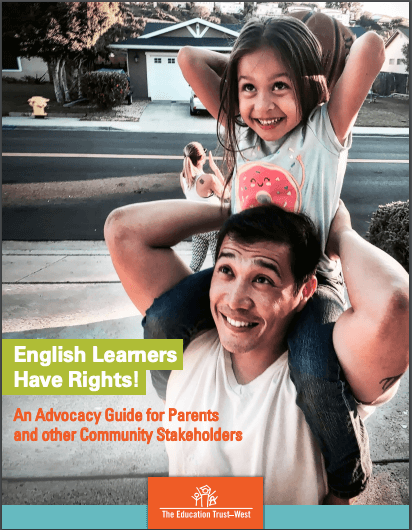
Reading doesn’t come naturally. It’s a sophisticated skill that has to be taught and learned. It requires guidance and a lot of practice.
In This Lesson

Are California kids learning English?
How do schools teach English literacy?
What is media literacy?
What are the Common Core Standards for English Language Arts and Literacy?
How many kids are learning English in school?
What is the ELPAC?
What happened to CELDT?
What languages do California's English Learners speak?
Are California schools required to teach in English?
What are propositions 227 and 58?
▶ Watch the video summary
★ Discussion Guide
It's also a fundamental skill. Every student has to make the jump to reading. As discussed in Lesson 2.7, some kids struggle more than others. Ensuring that all kids can read — including those that struggle — is a core responsibility of the education system. Kids learn to read so that they can read to learn.
This lesson explores literacy from many angles. What counts as literacy? What are the standards, and are we achieving them? How are expectations and programs different for students that speak English at home versus those who learn it at school? What approaches help students learn?As A.I. improves, how should educators think about media literacy, the capacity to apply critical thinking when reading or watching material? We'll start with the standards.
What are reading standards?
Each state defines educational standards to describe what schools should teach and what students should learn at each grade level. Along with other states, California uses the Common Core State Standards for English Language Arts and Literacy to define these expectations. The standards are organized into four broad areas of English language readiness: reading, writing, "speaking and listening," and the use of language.English literacy in education
The Common Core standards establish expectations that are broader than English class: they set requirements for literacy in history/social studies, science, and technical subjects.
From about 6th grade on, teachers in history, science, and other subjects help students develop literacy skills through practice. Students develop English skills in many classes — not just in English class. For example, the standards don’t say a student has to take physics. But if a student does take physics, then the teacher needs to supplement content information with instruction on how to read the textbook, write about the subject, and so on.
The Common Core defines a set of capacities that students need to exhibit with increasing "fullness and regularity" (Yes, it's education jargon, but read on. We explain.)
|
The Common Core English Language Arts Capacities |
|---|
| They demonstrate independence. |
| They build strong content knowledge. |
| They respond to the varying demands of audience, task, purpose, and discipline. |
| They comprehend as well as critique. |
| They value evidence. |
| They use technology and digital media strategically and capably. |
| They come to understand other perspectives and cultures. |
To provide guidance to school districts and curriculum developers, standards are accompanied by a curriculum framework.
School districts approve their own materials.
School districts in California have the authority to select materials and certify that they are aligned with the standards. (This was a big change; prior to 2013, materials had to be reviewed and approved by the State Board of Education.)
California has a weak record when it comes to literacy. In 2019, California placed 41st in the nation on 4th grade reading and 39th in the nation on 8th grade reading. In late 2022, EdSource ran a special report about the crisis. Effective change will require coordinated action throughout the system, including better learning materials, seriousness about the science of reading, and attention to results. California's annual state test shows huge gaps between student scores based on race/ethnicity, economic status, and English Learning status:
English Learners
In California, about 40% of public school children speak a language other than English as their first language. In education-speak, these students are called English Learners (EL) or English Language Learners (ELL).
In California, about 40% of public school children are "English Learners" who speak a language other than English as their first language.
Schools gauge students' progress toward fluency using the English Language Proficiency Assessments for California (ELPAC, pronounced ELL-pack). After an initial assessment, students are tested annually to evaluate their progress. When a student scores high enough, teachers and parents may reclassify them as fluent.
Schools and districts must support literacy development
If your school has more than twenty English Learners, according to California law it must set up an English Language Advisory Committee (ELAC, pronounced "EE-lack"). This committee's purpose is to advise your school's leadership, particularly when it comes to determining the goals expressed in the School Plan for Student Achievement (SPSA, usually pronounced "SIPsuh"). Here are sample meeting materials from the ELAC for Cerritos High. Although the purpose of an ELAC is advisory, it can play an influential role. Some districts suggest establishing bylaws to clarify roles and expectations.
Your school district is also required to have a similar committee at the district level (DELAC, pronounced "DEE-lack") to advise the district's school board on programs and services for English Learners. This advice is meant to include input on your district's annually-updated three year plan (the Local Control Accountability Plan — see Lesson 7.10 for more about the LCAP). ELACs and DELACs became prominent tools for engaging parents after the passage of Proposition 58 in 2016 expanded bilingual education programs in the state.
Research about English Learning in California has been difficult because of the limitations of California's education data systems. In 2018, a prominent research project (Getting Down to Facts II) found that English Learners are more likely than other California students to be taught by early career teachers. In their conclusion, the authors argue for more clarity:
"The state should be concerned if new teachers, who are already struggling with so much, are particularly underprepared to teach ELs. Ensuring that novice teachers are adequately prepared with the specialized skills, knowledge and dispositions to teach ELs is of paramount importance to a state that concentrates one-quarter of all ELs in the nation — an extremely vulnerable and at-risk population by any measure."
If your school district has a pattern of assigning inexperienced teachers to schools with high concentrations of English Learners, your Site Council, ELAC and DELAC should be talking about it. School districts are obligated to provide cost-free training to members of ELACs and DELACs. If this isn't happening, you could bring it up in the process of reviewing and renewing your district's LCAP. (Ahem... May we point out that Ed100 is available in English and Spanish? If your ELAC members aren't aware of Ed100, please drop them a note!)
Bilingual education
California's standards for English Language Development (ELD) help guide instruction for the state's English learners. Most California students who are learning English speak Spanish at home.
California's English Learner Roadmap, created in 2017, sets out a path for improving instruction for English language learners. In 2018, research conducted for the Getting Down to Facts II project suggested a to-do list that includes stronger investment in programs to prepare bilingual teachers and improved access to preschool for English learners.
The changing politics of multilingual education
Bilingual education used to be controversial in California. In 1998, voters passed an initiative (Proposition 227) that required nearly all California public school instruction to be conducted in English.
Educators in California are not limited to teaching in English
Times change. In 2016, voters reversed course and overwhelmingly repealed the ban. Schools now may choose how to teach English learners, whether in English–only, bilingually, or in other types of programs.
(Ed100 Lesson 6.16 provides research on the importance of biliteracy skills, and on the California State Seal of Biliteracy).
Phonics and the reading wars
Teachers can be passionate about their work, and can sometimes be inflexible about how to do it well, even in the face of evidence. A great example of this dynamic has been dubbed the reading wars, a long-simmering disagreement over how to teach English to early readers.
The debate has been widely simplified as a question of approach: should all students be taught to decode words phonetically (the phonics camp) or it is enough for students to recognize words in context (the whole language camp)?
Researchers have concluded that the phonics advocates are basically right. California's weak results in language arts are partly the result of a long embrace of a reading strategy that doesn't work for all kids. Whole language teaching methods on their own don't tend to work well for struggling readers or students with reading issues. In order to read, students need to be able to decode words and comprehend language. Meanwhile, publishers have attempted to skirt the conflict by developing materials that include elements of both approaches.
Sold a Story
For much more about the Reading Wars, listen to the award-winning podcast series Sold a Story from American Public Media. The series explains the painfully slow process that led from ineffective teaching practices to better ones, and the roles that research and media played in the change. In 2025 a new episode was added to spotlight the Trump Administration's executive actions to defund education research.
Does reading matter anymore?
The digital era forced new thinking: what constitutes “reading” and how does that play into how we define literacy? Now, you might be thinking the answer is pretty simple. Students with reading literacy skills can look at words on a page and answer questions about the content, right? But what about content from videos, audio, or other digital sources? Surely comprehension of non-written sources has some role in students’ overall literacy. Teachers, education policymakers and test designers are currently grappling with how large a role that will be.
For now, at least, reading remains the primary skill that matters for test scores and progress in school. As time goes on, the debate might be settled in the same way the reading wars weren't: Elements of both reading skills and digital skills will be included, probably with unclear guidance. So, how can you best support the literacy development of your child right now?
Media Literacy and A.I.
It's dangerous to assume that things you read or see are true. Schools play an important and growing role in teaching students how to detect biases and discern truth from untruth. In 2023, as generative artificial intelligence tools (A.I.) began to become widely available, the California legislature wrestled with policy options to quickly insert media literacy into curriculum frameworks. As of this writing in 2025, the state Department of Education has collected resources and convened an advisory AI in Education working group group that is charged with releasing draft recommendations by Jan 1, 2026.
Next steps for developing English language skills
Literacy starts at home. The earlier the better. There is some evidence that children from high-income families are exposed to more words than children from families on welfare — the gap was once reckoned to be as large as 30 million words. Research now indicates that reading to children builds richer language skills than talking with them. It makes sense: The language in books is usually more enriching than everyday speech.
How is your school supporting English Learners? This advocacy guide from EdTrust-West helps parents and communities know their rights, which still apply in 2025.
Schools and parent groups can do a lot to support literacy at home. For example, Reading Rockets provides resources in many languages. The California State PTA provides grade level guides to help parents understand California's literacy standards.
Next we’ll look at fluency of a different sort: science, technology, engineering, and math, known in edu-lingo as the "STEM" subjects.
This lesson was updated in October, 2025
CHAPTER 6:
The Right Stuff
-
The Right Stuff
Overview of Chapter 6 -
Grade-level Expectations
How Do Common Core Standards Work? -
Academic Rigor
Is School Challenging Enough? -
Literacy
Ensuring All Kids Learn to Read, Write and Speak English -
STEM
Science, Technology, Engineering and Math -
Tests
Why Tests Matter and How They Work -
Technology in Education
Tools for teaching and learning -
Student engagement
How to make school interesting -
Arts Education
Creating in School -
P.E. and Athletics
How does sweat and movement help learning? -
Let’s Go!
What Makes a Field Trip Great? -
Career Technical Education
Education for career opportunities -
Service Learning
Learning to Help Others -
Social-Emotional Learning
Education for Mental Health -
Character
Can Values and Habits be Taught? -
Civics, history and geography
How do kids learn about their country and the world? -
World Language Learning
The Cure for Ugly Americans -
Financial Literacy
Learning to Earn
Related
Sharing is caring!
Password Reset
Search all lesson and blog content here.
Login with Email
We will send your Login Link to your email
address. Click on the link and you will be
logged into Ed100. No more passwords to
remember!

















Questions & Comments
To comment or reply, please sign in .
Carol Kocivar November 4, 2025 at 4:44 pm
"Summary: A new study reveals that young children learn letters and word structures more effectively through handwriting than typing. Researchers taught 5- to 6-year-olds unfamiliar letters and pseudowords using either manual writing or keyboards.
Those who practiced by hand performed significantly better on tests of recognition, writing, and pronunciation, especially with unfamiliar word sequences. The study highlights the importance of graphomotor movements in developing reading and writing skills and suggests handwriting should remain central in early literacy education."
https://neurosciencenews.com/hand-writing-learning-28806/
Carol Kocivar November 4, 2025 at 2:14 pm
"The EdVoice Institute has released a progress report on the rollout of universal screening for reading difficulties in K-2 classrooms—an important milestone in California’s comprehensive plan to uplift student reading outcomes across the state. EdVoice Institute has tracked and advanced implementation from screener selection to teacher training. As part of this effort, the organization analyzed 150 representative school districts across California and found that 100% have successfully adopted state-approved reading screeners."
Jeff Camp - Founder September 16, 2025 at 7:19 am
Carol Kocivar April 24, 2025 at 3:17 pm
"Despite a newfound national focus on the science of reading, states, including California, aren’t doing enough to support and train teachers to effectively teach literacy, according to a report released Tuesday by the National Council on Teacher Quality. Thirty-two states have passed laws or implemented policies related to evidence-based reading instruction in the last decade. Despite that, nearly every state could do more to support literacy instruction, according to the report, “Five Policy Actions to Strengthen Implementation of the Science of Reading.“ [via via EdSource]
Carol Kocivar December 28, 2024 at 4:36 pm
https://www.edweek.org/teaching-learning/4-things-to-know-about-the-literacy-lawsuit-targeting-lucy-calkins-and-fountas-pinnell/2024/12?utm_source=nl&utm_medium=eml&utm_campaign=popweek&M=12004226&UUID=0bce682728fff1c2bdffb81541b25c1f&T=15765445
Carol Kocivar December 28, 2024 at 4:08 pm
"A panel of reading experts has designated the tests that school districts can use to identify reading difficulties that kindergartners through second graders may have, starting next fall.
Gov. Gavin Newsom’s announcement Tuesday of the selection of the reading risk screeners marks a milestone in the nearly decadelong campaign to mandate that all young students be measured for potential reading challenges, including dyslexia. California will become one of the last states to require universal literacy screening when it takes effect in 2025-26."
https://edsource.org/2024/reading-test-dyslexia-california-schools/723952
Carol Kocivar December 17, 2024 at 5:26 pm
PUBLISHED DECEMBER 4, 2024
While research indicates it can take 5–7 years to develop English proficiency, classification as an EL for many years may also indicate that students are becoming stuck at lower levels of English proficiency due to lack of appropriate learning supports, which may prohibit them from accessing the full school curriculum. Better understanding of which students are classified as English learners for long periods, and are likely to need additional support, will be key to helping students reach their educational potential.
https://learningpolicyinstitute.org/product/ca-long-term-english-learners-report?utm_source=LPI+Master+List&utm_campaign=6ca05e8e4a-LPIMC_December2024Update_2024_12_17&utm_medium=email&utm_term=0_-6ca05e8e4a-42325679
Carol Kocivar January 27, 2024 at 1:30 pm
On-Demand Dyslexia Online Course Bundle: This free three-part online course covers the topics of understanding dyslexia and dysgraphia, intensifying instruction for struggling readers, and serving students with dyslexia for school psychologists. Participants have until October 1, 2024, to complete the coursework.
https://courses.gleaneducation.com/bundles/CDI
Carol Kocivar January 31, 2023 at 3:30 pm
.https://ed100.org/blog/literacy-crisis
Carol Kocivar August 4, 2022 at 1:42 pm
Myesha Mebane September 8, 2022 at 12:45 pm
Jeff Camp - Founder September 21, 2022 at 7:45 am
Carol Kocivar August 3, 2022 at 9:27 pm
The Budget also provides $10 million for the Department of Public Health to partner with First 5 California on the Books for Children Program.
Carol Kocivar July 5, 2022 at 3:13 pm
"If you can’t read a math problem, you can’t solve it. And even if you can read it—or listen to someone else read it—if you don’t have the vocabulary you need to understand it, you’re also out of luck."
Natalie Wexler
https://www.forbes.com/sites/nataliewexler/2022/06/21/when-language-prevents-kids-from-succeeding-at-math/?sh=a57ece6623da
Carol Kocivar June 14, 2022 at 3:03 pm
Alisa Sabshin-Blek August 24, 2020 at 12:29 pm
Frida November 4, 2019 at 10:32 am
https://www.apmreports.org/story/2019/08/22/whats-wrong-how-schools-teach-reading
Susannah Baxendale February 2, 2019 at 11:10 am
Jeff Camp February 2, 2019 at 1:04 pm
nkbird August 12, 2018 at 4:21 pm
Jeff Camp August 13, 2018 at 4:38 pm
Carol Kocivar December 2, 2017 at 11:16 am
https://www.elpac.org/resources/practicetests/
Carol Kocivar July 19, 2017 at 3:05 pm
Carol Kocivar February 12, 2017 at 9:54 am
Carol Kocivar March 12, 2016 at 1:43 pm
The California Multilingual Education Act (Senate Bill 1174) repeals the requirement that all children be taught English by being taught in English and instead allows school districts and county offices of education, in consultation with language experts in the field and parents, to determine the best language instruction methods and language acquisition programs to implement.
Find out more...https://ballotpedia.org/California_Multilingual_Education_Act_(2016)
Carol Kocivar November 9, 2015 at 10:51 am
A little easier reading presentation:
http://www.cde.ca.gov/sp/el/er/documents/eldstndspublication14.pdf
g4joer6 April 15, 2015 at 9:39 pm
dnplank May 4, 2011 at 1:59 pm
If we want our students to master the conventions of standard English we have to TEACH them those conventions, not just in ESL class but across the curriculum. Doing this would require us to think very differently about how schools work, though, so instead we shift the main burden of responsibility to the students themselves.